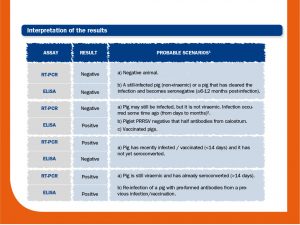Diagnostic tests are absolutely necessary to confirm PRRS. The most common used techniques are ELISA and PCR.
PRRS Diagnostic tools
The ELISA technique detects antibodies produced against the infectious agent, and the PCR technique detects the presence of genetic genetic material of the infectious agent.
The first technique, in this case the ELISA for PRRS, detects the antibodies in blood for a long period of time, usually for several months in the case of IgG for PRRS.
The viraemia of the virus (its presence in the blood that is detected by PCR) usually lasts much less time than the antibodies that are detected by ELISA.
Interpretation of the results
The interpretation in this case is the following: the animals have been in contact at some point with the PRRS virus, they have produced antibodies detectable by ELISA, but at the time of sampling (and analytics) there were no virus in the blood of the animals.
This situation is ideal, for example, in an adaptation program of negative gilts before entering in a PRRS positive farm.
Positive ELISA and negative PCR gilts are protected with antibodies but they are not viraemic and do not shed the virus.
For more information regarding diagnostic tools and its interpretation, visit champter 5 “Detection of virus” and 7 “Detection of antibodies” of this site.
You can ask your own question! Visit Pig333.com and submit your question to the experts.
¿Cómo interpretar un resultado ELISA positivo y PCR negativo para PRRS a partir de un muestreo sérico?
El diagnóstico laboratorial es absolutamente necesario para confirmar el diagnóstico de PRRS. Las técnicas más usadas son ELISA y PCR.
La técnica ELISA detecta anticuerpos producidos frente al agente infeccioso, y la técnica PCR detecta la presencia de material genético del agente infeccioso.
Técnicas de diagnóstico
En la primera técnica, en este caso el ELISA para PRRS, los anticuerpos se detectan en sangre durante un largo período de tiempo, normalmente varios meses en el caso de las IgG para PRRS.
La viremia del virus (su presencia en la sangre que se detecta por PCR) suele durar mucho menos tiempo que los anticuerpos producidos que se detectan por ELISA.
Interpretación de los resultados
La interpretación en este caso que comentas es la siguiente: los animales han contactado en algún momento con el virus PRRS, han producido anticuerpos detectables por ELISA, pero en el momento del muestreo (y analítica) ya no hay virus circulante en los animales.
Esta es la situación ideal por ejemplo cuando se hace un programa de adaptación de primerizas negativas antes de entrar en una granja PRRS positiva.
Las cerdas ELISA positivas y PCR negativasestán protegidas con anticuerpos pero ya no están virémicas y no excretan el virus.
Para más información sobre herramientas de diagnóstico y su interpretación, visita los capítulos 5 “Detection of virus” y 7 “Detection of antibodies” de este sitio.
Puedes formular tu propia pregunta! Visita 3tres3.com e introduce allí tu pregunta a los expertos.

Universidade Lusófona de Humanidades e Tecnologias – Portugal





